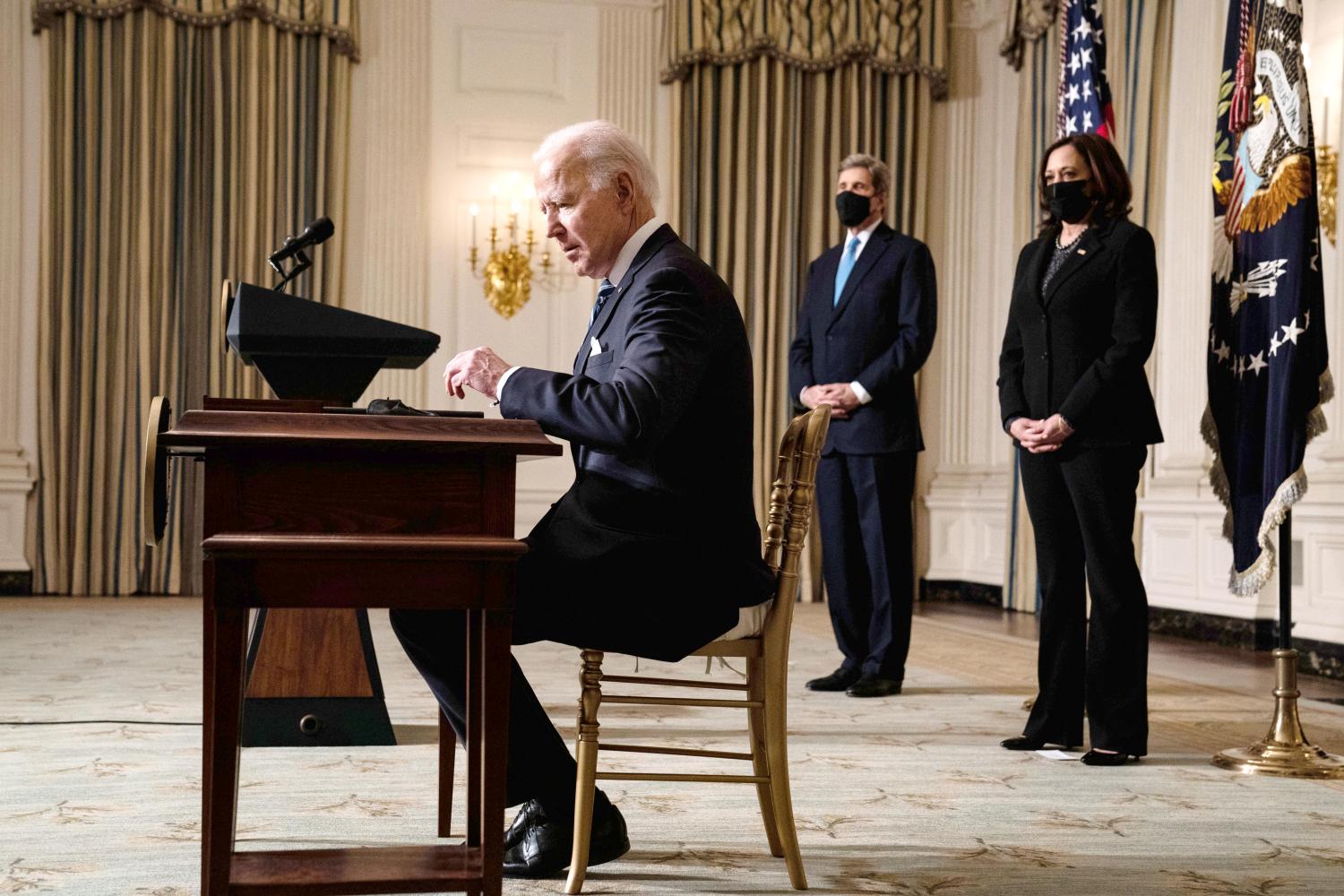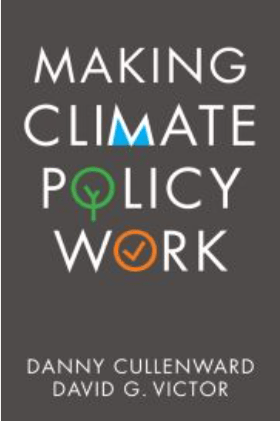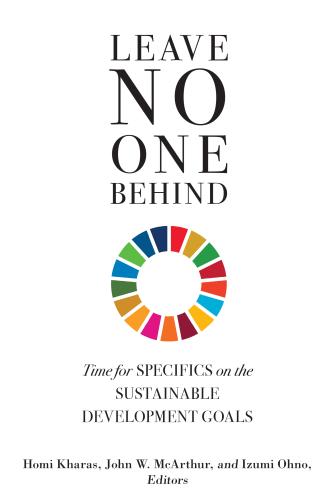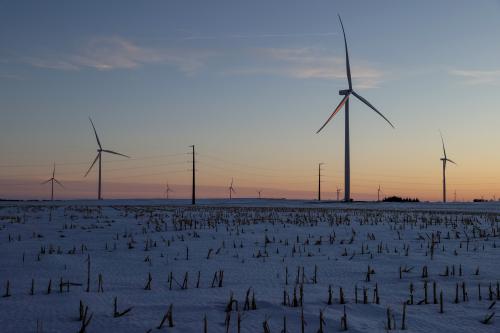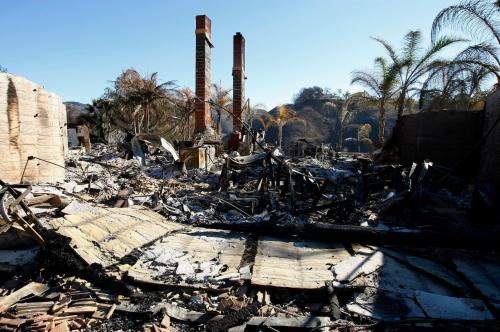This brief is part of the Brookings Blueprints for American Renewal & Prosperity project.
Contents
- Summary
- Challenge
- The global and national context for accelerating U.S. climate action
- Policy recommendations
- Conclusion
Summary
The United States is rejoining international efforts against climate change in a crucial year. All members of the Paris Agreement are obliged to submit updated pledges for emissions reductions prior to a global climate meeting in November. President Joe Biden wants to re-establish U.S. leadership on climate. Doing so will require the United States to make an ambitious but achievable pledge and to assist other nations in doing the same. The political landscape for enacting climate legislation in the United States is still tricky, but U.S. subnational actors have continued emissions reduction efforts during the Trump administration and will be a key part of efforts going forward. These subnational actors can share their skills and ambition with their counterparts abroad. The United States also has an opportunity to lead through its role in the global financial sector. It can encourage greener investing by requiring disclosure of climate risks and support global efforts to finance emissions reduction and climate adaptation in developing countries.
Challenge
2021 has the potential to be a year of rapid advancement on climate change. The European Union, China, Japan, and South Korea have all announced new and ambitious near- and long-term climate targets, and every member of the Paris Agreement is obliged to update their pledges prior to the November Conference of the Parties (COP) meeting. Non-government actors and sub-national governments around the world are also committing to ambitious long-term goals. Most of these goals focus on reaching net-zero emissions by 2050. As the international community gears up for the COP event, political attention to climate is the highest it has been since the runup to the Paris COP in 2015. Expectations are high for commitments that honor the Paris Agreement goal of limiting warming to “well below” 2°C above pre-industrial levels.
Four years of U.S. absence from the global climate community — including global climate negotiations and international efforts to reduce greenhouse gas emissions — have left a big gap in international leadership and credibility.
In this context, the reaction in the global climate community to Joe Biden’s election as U.S. president has been overwhelmingly positive. The world sees the importance of U.S. action to limit overall global temperature rise, and President Biden’s campaign, appointments — including former secretary of state John Kerry as special presidential envoy for climate — and early actions in office indicate his interest in a new approach to climate change. However, the Biden administration immediately faces a difficult challenge. Four years of U.S. absence from the global climate community — including global climate negotiations and international efforts to reduce greenhouse gas emissions — have left a big gap in international leadership and credibility. How does the new administration meet the moment? How does the United States regain its credibility on the world stage?
Since greenhouse gas emissions mix throughout the global atmosphere and oceans, emissions in one part of the world impact the climate everywhere. The Paris Agreement calls for all countries to reduce emissions in line with their own development goals and political realities. But science suggests that a goal of net-zero emissions from the largest emitting countries by mid-century is necessary. In this context, credible U.S. action is critical. As the world’s largest economy, second-largest greenhouse gas emitter, and superpower re-engaging on climate diplomacy, U.S. actions can either dampen or accelerate global action. If the United States fails to make commitments that the rest of the world views as serious, it will be harder to pressure other countries to take more serious action. Credible U.S. action could form the basis for genuine leadership, as the United States displayed preceding the Paris COP through its bilateral commitments with China.
The good news is that Biden is appointing climate experts to positions throughout the executive branch and promises a “whole of government” approach to climate change. However, despite unified political control of the White House and (narrowly) Congress, the nation remains polarized on whether and how to respond to the climate crisis. Many actions that could move the United States toward a low-carbon economy do not require legislation and could be implemented with little or no bipartisan support, but given that such actions were reversed when the Trump administration replaced the Obama administration, these may not be enough to demonstrate U.S. credibility. U.S. leadership in innovation, financial markets, and civil society provide additional opportunities for international engagement and action.
Changes in how we understand the low-carbon transition are an additional source of good news. The conversation on climate action is shifting from one focused solely on costs to one centered around opportunities: for low-cost renewable electricity generation, for growth in jobs and communities, for greater justice for communities that have long been disproportionately affected by pollution, for development in countries that currently lack modern energy services. The cost of renewable electricity has fallen rapidly and technological advancements in other sectors, like batteries, are reducing the cost of decarbonization. A zero-carbon world is coming into view.
The global and national context for accelerating U.S. climate action
The United States sat on the sidelines for four years of global climate action, and the world changed while we were away. The science about climate change became clearer and our allies and partners abroad are stepping up their national climate strategies in response. Now that the United States is back in the game, they expect ambitious action, including a new U.S. climate target or nationally determined contribution (NDC). In this context, after whipsawing political positions on climate change, the United States must advance a credible strategy for robust and continued climate action at home that is seen as reliable and not subject to reversals over time.
In some ways, such action at home faces headwinds, but in other ways there are reasons for optimism. With Congress finely balanced, the pathway for successful legislation on climate has narrowed. Moreover, the White House and Congress are focused on the immediate crisis of the COVID-19 pandemic and the resulting deep economic recession. At the same time, a strong set of near-term options exist to embed policies to support climate action, low-emission transportation, and clean energy development into current discussions around economic recovery and investment. In this way, spending designed to pull the nation out of the recession would encourage investments to reduce emissions and increase resilience to climate change.
Another element that has changed in the past four years — and that supports enhanced domestic climate policies and international credibility — is the increased breadth and depth of sub-national action on climate in the United States. In fact, subnational actors with significant climate commitments (including states, cities, and businesses) represent roughly 70% of U.S. GDP — equivalent to the world’s second largest economy, roughly the size of China’s. Using policy authorities at their disposal, many of which are significant, these actors have advanced climate action across multiple sectors and greenhouse gases, including electricity, clean transportation, land use, methane, hydrofluorocarbons, and more. Even outside of federal regulation and legislation, such policies already are driving significant reductions in U.S. emissions and could do more if expanded in line with recent trends. As another example, over 600 local governments in the United States have developed climate action plans. While the majority of these municipalities are lagging in their efforts to meet their targets, some large cities (Los Angeles, New York City, and Durham, North Carolina, for example) have achieved significant reductions and have highly qualified organizations to demonstrate how such reductions can be achieved.
Policy recommendations
Against this backdrop, the United States can and should re-engage fully with the international community to support global action. To do so, it must act in five linked ways.
As the federal government dismantled its climate efforts, the subnational community substantially increased its climate commitments. As a result, the United States has highly motivated and experienced actors outside the federal government.
Embed climate action into U.S. society. The core project for the United States this year, and for years to come, is to develop and implement a national climate strategy that brings to bear all possible areas of policy action. In many ways the U.S. is playing catch-up, but one important advantage developed during the Trump years. As the federal government dismantled its climate efforts, the subnational community substantially increased its climate commitments. As a result, the United States has highly motivated and experienced actors outside the federal government. Federal action to catalyze and encourage these local efforts will be a key part of a bottom-up climate strategy, enabling more robust policy through oscillating political cycles at the national level.
Subnational actions are key, but some actions must take place at the federal level. New legislation is a first potential contributor. Given the current makeup of Congress, actions rooted in tax credits, investment, and stimulus are likely to have some traction in the near term. Other policies will have to be evaluated in light of their potential support. A second possible contributor is administrative actions that can be implemented by the executive branch, including regulatory actions under existing laws. Such administrative actions are less durable than legislative outcomes, but remain on the table as options.
Advance subnational diplomacy. While not all countries are structured like the United States, bottom-up leadership and implementation are central to success in some form in all countries. The United States can use its non-federal actors in its diplomatic efforts to support and bolster climate action around the world. For this, U.S. cities, states, and businesses can collaborate with their counterparts in other countries to discuss opportunities and strategies, supported by the U.S. diplomatic effort. Such efforts could take place through a U.S. State Department Office of Subnational Diplomacy, as recommended by Anthony F. Pipa and Max Bouchet in their brief for this series.
Announce an ambitious yet credible U.S. nationally determined contribution. As a central pillar of the Paris Agreement, countries around the world regularly offer their NDCs and report on progress. Each country’s NDC is viewed as an indicator of the country’s overall climate ambition. The U.S. target will likely have an outsized impact on overall global action this year. President Biden has committed to offer the next U.S. NDC at a leaders’ meeting that he will host on Earth Day, April 22. In parallel with developing the national climate strategy, Washington will be undertaking an assessment of the possible emissions reductions associated with such a strategy. International perception of the U.S. domestic commitment is important; the commitment must be seen as sufficiently ambitious to unlock the other diplomatic opportunities available to the United States. The goal of achieving emissions reductions of approximately 50% below 2005 levels by 2030 is receiving a great deal of attention, but is highly ambitious for the United States. Achieving such a target would be a challenge, but the whole-of-society approach described above could improve the probability of reaching such a goal.
Revisit U.S. domestic financial regulations and international climate finance. Mobilizing new sources of finance to support a rapid economic and technological transition is central to addressing climate change. Here too, the United States provides an important link between domestic and international actions. Domestically, the U.S. financial system leads the world, but U.S. financial regulations do a poor job of requiring disclosure of climate-related risk, including the physical risks associated with climate change. Recent movement toward addressing these issues can be accelerated. For example, the Federal Reserve recently joined the Network for Greening the Financial System and Treasury Secretary Janet Yellen made clear in her confirmation hearing that she believes climate change is a risk to the financial system. Through its outsized influence on the global financial system, the United States can encourage greener investment. Greater disclosure of climate risks would allow investors to direct funds to low-carbon and resilient assets, potentially moving the needle in areas where policy lags behind.
The United States must also exercise leadership in marshalling the financing that developing countries, especially the larger emitters, will need to raise their climate ambition, and to help poor and vulnerable countries adapt to the already evident impacts of climate change. This includes ensuring that developed countries live up to their commitment to mobilize $100 billion per year in climate finance, a central tenet of the climate accords. For the United States, meeting its commitment to the Green Climate Fund, established under the U.N. climate framework a decade ago, will be an immediate litmus test. The United States must also play a leadership role in unleashing the potential of the International Monetary Fund and the multilateral development banks in supporting more ambitious climate action. These institutions can play a role beyond their own financing by catalyzing private investment through reducing and sharing risk. The COVID-19 pandemic provides an opportunity to “build back better” by tackling the interrelated challenges of job growth, climate change, pollution, and biodiversity.
Support international efforts and national strategies. The United States can employ its substantial foreign policy apparatus to engage with key countries, partners, and allies around the world. In doing this, the United States can first communicate how it will achieve its own ambitious goals, then seek to understand how other countries anticipate delivering on their own goals and work with them bilaterally or multilaterally to support their national climate strategies. Finally, it can work with partners around the world to ensure that there is broad support for a strong outcome at the climate conference later this year.
Fundamentally, the climate challenge requires pushing the technological frontier in a dozen key sectors, from electricity to cars to building materials. In every sector the challenge is different, and in every sector there are different arrays of international partners, such as national and subnational governments and pioneering firms. The United States should ally with the U.K. government as it advances key “campaigns” that reflect this sector-focused approach to deep decarbonization. The effort should identify a few sectors, such as cars and electricity, where the United States is at the frontier and can particularly shape the global effort.
Conclusion
When the Paris Agreement was concluded in 2015, the world took a significant step toward addressing climate change. Paris established an architecture to encourage a global “race to the top” of climate ambition and catalyzed the first set of national climate targets as a down payment on a global emissions trajectory toward net zero. The intervening years have seen some negative forces, such as the U.S. opposition internationally and rollbacks domestically, and more recently the pandemic and economic recession. Yet there have also been positive surprises — increased national ambition in many other countries, continued advancements in the quality and cost of clean technologies, and the groundswell of subnational action in the United States and elsewhere. U.S. global leadership on climate is again a possibility and the opportunity for a new, major step on climate change is palpable. This moment has arrived just in time to have a chance to put the world on a safer climate trajectory. U.S. action today, with a joint domestic and international strategy, is critical for our shared global success.
-
Acknowledgements and disclosures
Ted Reinert edited this paper. Amar Bhattacharya and David G. Victor provided invaluable comments.
The Brookings Institution is committed to quality, independence, and impact.
We are supported by a diverse array of funders. In line with our values and policies, each Brookings publication represents the sole views of its author(s).


